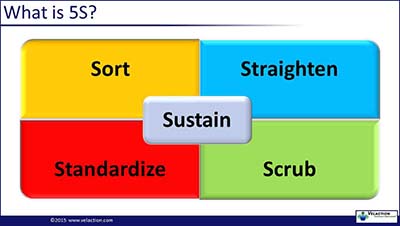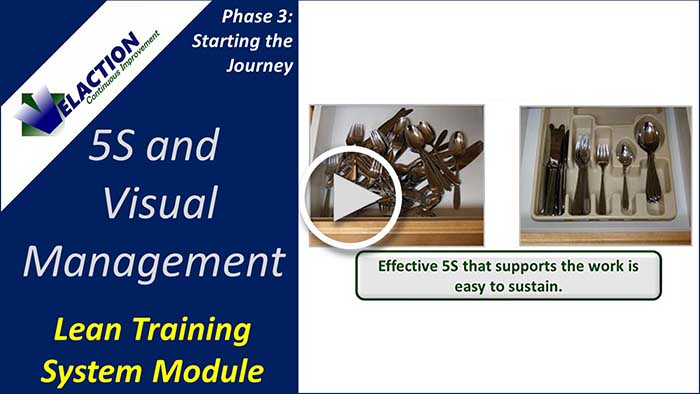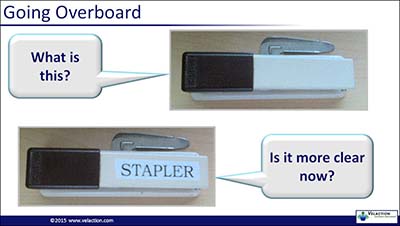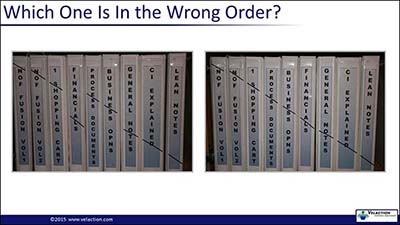5S
One of the fundamental tools in any Lean toolkit is 5S. In a nutshell, it entails creating an organized, effective workspace that supports the processes being performed in the area.
You Probably Already Use 5S at Home
The original 5S terms come from Japanese words:
- Seiri (Sort): This step entails getting rid of clutter and unused items.
- Seiton (Straighten): This step entails arranging the work in a manner that makes jobs easier to do. “A place for everything…”
- Seiso (Scrub): This step entails not only doing an initial cleaning but also making it easy to keep the area clean. Avoiding dirt is part of 5S.
- Seiketsu (Standardize): This step entails making and ‘locking in’ the locations designated with ‘straighten.’
- Shitsuke (Sustain): This is the industrial discipline that keeps 5S in place. It is the continuation of the expression started in ‘Straighten’ above: “…, and everything in its place.”
Because translation is an inexact science, you might see many different versions of 5S. Some of the most common terms include: sort, simplify, systematic arrangement, set in order, spic and span, scrub, sweep, shine, standardize, stabilize, sustain, and self-discipline. The same term (i.e. simplify) may even describe different steps and have alternate meanings in different companies.
Velaction’s Recommended 5S Components:
- Sort
- Straighten
- Scrub
- Standardize
- Sustain
In truth, though, whatever version is used, you will likely find an underlying current of common sense in it. In fact, you and your team likely use many of the concepts in your home life, so it should not be a big stretch to apply the same logical principles of 5S in your factory or Lean office.
One of the most common examples of 5S in the home is the ubiquitous plastic tray in the silverware drawer (shown earlier).
Ultimately, the goals of 5S are to reduce waste, ensure efficiency and effectiveness, and ultimately improve productivity in the workplace.
Often, organizations will audit their 5S efforts. Some evaluate progress as an overall “S” level (1S, 2S, etc.). Others assess each individual component of 5S on its own scale. Many of these assessments include a formal audit process.
Regardless of which set of 5S terms your organization uses, and how the system is measured, the intent of a 5S system should be to improve the flow of work through the value stream.
NOTE: Using 1S, 2S, 3S, etc. as a level is nice from a simplicity standpoint, but I am not a fan of doing it. It can be confusing to people who are not well-versed in Lean because it uses the ‘S’ concept as both a level and a category.
Watch our 5S and Visual Management Video

5S can help in a variety of situations. Look through the list below to see if you recognize any of the following undesirable conditions:
- People are borrowing tools or office supplies from each other.
- People spend time searching for materials in an office supply cabinet.
- People walk to a shared workspace like a print station, and then have to go back to their desk to get a hole punch.
- Shared workspaces or break areas are in chaos—old coffee cups, spills, missing items, empty material bins, equipment in the wrong location. Debris accumulates around a copier or shipping station.
- People grab the wrong size wrench or the wrong part to put on a product.
- People search for parts that are not in the right location. There’s an old joke, ‘You always find something in the last place you look for it.” The problem is that the last place sometimes takes quite a while to get to.
- An investor looks at the clutter around a workstation and shakes her head.
- A customer sees a disorganized office and takes his business elsewhere.
- A person on the phone searches for a pencil while an irate customer continues to escalate.
If you learn how to 5S you will find that it is a simple and powerful method that really does work to help eliminate these conditions. It has a measurable impact on efficiency, primarily by reducing the time it takes to find things, walk to get things, or prepare workspaces for use.
The intangible benefits of learning how to 5S come in a variety of forms. A supervisor observing an employee who is well-versed in 5S generally has more confidence in him. The employee who is able to keep a workspace finely tuned to the process appears far more competent than one who works in an area of disarray.
Also think about investors and customers. Would you put your money into a company that looked completely disorganized? Would you buy your lunch from a filthy restaurant? Retail stores generally understand the need to make good impressions on customers. They keep their stores orderly, prominently label their goods, and are constantly cleaning. They do this because they understand the financial impact of image.
People whose areas are 5S’ed also seem to be a little more relaxed than those working in chaos. They can always find just what they need in a crisis, preventing the increase of stress on the job. They also are able to limit the frustrations that come from searching for tools and materials or having to make do with an inadequate workspace.
Steps to 5S a Work Area
I recommend using the following general steps as you learn how to 5S:
- Sort/Simplify: Go over the area you are 5S-ing and remove all the clutter. A rule of thumb is to move anything that has dust on it out of the area. Another method is to use a time limit. For example, if an item hasn’t been touched in the last week, move it out. Using a red tag campaign will support this step of the process. Items used infrequently should be moved to a central location. There, other people have a chance to claim the equipment to use in their own work areas. After a designated time, dispose of unneeded items. In effect, you are pulling out all the unnecessary items from your work area, making it easier to find the remaining items that you do need.
- Straighten/Systematic Arrangement: This step entails establishing locations for the tools and materials that support a process. These locations should be in a logical order, though that logic varies based upon what you are doing. In some manufacturing cells, placing the tools in the order in which they are used make sense. In a mechanic’s shop, tools might logically be arranged in size order. You may decide that in an office environment, you are best served by arranging your area according to how frequently you use items. Some points to consider:
- Make the location easy enough to replace tools and materials with your eyes closed. It should be a smooth, easy motion. Pegboards commonly require some manipulation to get tools into their holders. Files can also require some effort to fit into a file drawer.
- Retrieving items should be, if possible, a one-handed motion that ends up with you holding the item oriented for use. Watch people picking up tools—there is frequently the twirl of the tool to get it ready to use—occasionally resulting in dropping the tool. As an example, pliers should be arranged with the handles facing you so you can immediately grab the tool as you would use it. Office supplies stored in drawers require one hand to open the drawer, and one hand to get the stapler. Instead, keep them out in the open on a small shelf or attached to a wall with Velcro.
- It is a good idea to have multiples of the same tool if it speeds up the process, and if the cost is not prohibitive. It does not take many trips back to your desk for a stapler to realize one should be located by the printer as well. The same principle applies to manufacturing If a person is frequently walking back to a shadowboard to get a tool, buy another one and keep one at each location where it is used. It is surprising how often countless walking steps are added to a process due to skimping on a $5 hand tool.
- If you own the equipment, you can modify it (safety permitting!) to fit your needs. You can attach anything you want to walls, glue hooks on equipment, etc. to make them easier to manage.
- Organize according to Standard Work. Strategic placement and sequencing of tools and materials will encourage people to follow proper processes. Remember—Step 1 got rid of the tools that are not needed, which further aligns the way production teams do things. Make it so that following the process is the easiest way to use the workstation. The layout of tools and materials should flow with the process.
- Scrub/Shine/Sweep/Spic and Span: Cleaning is the obvious part of this step. The less obvious parts are making cleaning easier and preventing messes in the first place. The less time your teams spend on cleaning tasks, the more time they will be available to do useful, productive Some tips:
- Get rid of flat surfaces whenever possible. They collect things. Make do with as little space as you can.
- Again, once you own something, you can do whatever you want to it. One simple thing to help keep clutter down on workspaces is to cut a hole in a bench and place a trash can below it. It makes it much easier to drop waste into.
- Figure out how to prevent waste in the first place. If you are frequently punching holes in documents and making a mess, consider using pre-punched paper. Eliminate cover sheets on fax machines and printers. If you are greasing or gluing something, talk to your engineering team and change the design to eliminate the need for messy adhesives and lubricants.
- Make processes self-cleaning. Dirty processes (such as welding) frequently have hoods overhead to pull the debris out of the air and prevent it from accumulating elsewhere. A small nozzle can blow every few minutes to push wire strippings into a bin rather than having to manually clear them away. (Always think safety when blowing anything!) Pull-out trays can be installed under grinding stations to catch debris. Use your imagination.
- Standardize/Stabilize: This step requires locking in your decisions, and is the part many people traditionally think of when visualizing how to 5S. The label maker and colored tape come out. The intent should be to ensure that abnormal conditions leap out at you. If your stapler was borrowed, it should be apparent immediately because of an empty outline on your desk labeled ‘Stapler’. If your materials have not yet arrived in your work area, you should see an empty space on the floor, complete with label. An empty space on a shadowboard tells you immediately that a tool is missing. This standardization helps reduce the amount of time spent looking for items. Searching is particularly bad because not only does it waste time, but you never know how long it will take. Warning: Some people go over the top and put a sticker on everything. One of the bum raps for 5S comes from seeing the ‘Phone’ sticker on the phone handset. 5S isn’t about labeling the obvious.
Don’t Get Crazy with Labeling
Some ideas for standardizing include:
-
- Mark locations with outlines and labels.
- Physically attach tools to a location whenever possible. Clip a flashlight to a chain where it is needed to check on fluid levels or tether a pen to a bank counter.
- Create cleaning processes and schedules. These should be written out. Often these instructions are in checklist
- Assign ownership to 5S. If nobody is specifically responsible for areas, organization tends to deteriorate.
- Sustain/Self-Discipline: Far and above, this is the most difficult step. Conventional wisdom says that it takes 30 days of practice for something to become a habit. In those 30 days, subtle lapses in the 5S of the area can derail progress. Items get left out. Work is put in the wrong location. Piles accumulate on a desk. This is when audits are the most critical—in the period immediately following changes in the 5S of an area. 5S is most effective when leaders at all levels support the 5S process. First off, they should set the example. It is hard to maintain credibility when leaders don’t practice what they preach. Managers’ offices should be kept in a highly refined state of 5S. Not only will it set a good example, but it will actually help the manager.
5S is one of the bedrocks of continuous improvement. Checklists, or sign-off sheets, (like you see for cleaning schedules in restaurant restrooms) are effective at helping ensure 5S is being maintained.
5S Examples and Special Situations:
- Some of the most common examples of 5S include shadowboards. These are pegboards that have either outlines of the tools, or a picture of the tool underneath them. When a tool is out of place, it becomes very apparent. Be careful, though, about when you use shadowboards. They look organized, but often consolidate tools away from the point of use.
- Cords present a special problem. Static cords (i.e. cords that just lay there, like power cords) should be bundled and kept off the floor. This makes cleanup easier and prevents having to pick the cords up when sweeping or vacuuming. It also prevents accumulation of dirt. Dynamic cords that are moved around, such as those on a meter test lead, or on a USB cord that is pulled out for an occasional photo download, can be arranged to fall back through a hole in a desk to keep them out of the way. Weights can be attached to make retraction easier. (For more information you can also read this article on how to organize cables.) When possible, though, go wireless.
- A series of binders on a shelf can have a large diagonal line drawn across the spines to highlight when one is out of sequence or missing.
Make Binder Order Obvious

5S Words of Warning
- Don’t be heavy handed with 5S. It should make life easier, not harder. Be flexible with how it is implemented but be firm that standardization and organization is a job requirement.
- Settle disputes with a stopwatch. Opinions may vary, but the watch doesn’t lie. Time a third party doing the work with the two layouts in question, so it takes process familiarity and individual speed out of the mix. Agree in advance to go with the faster one (assuming all other things are equal)…
- …or have the full team vote on the decision. That way the team has a voice. Just keep in mind that a vote is temporary. Votes are not supported by hard data. Then measure the process with the new locations and keep working to reduce the time.
- Don’t think of 5S as permanent. Even labeled and fixed locations should change regularly as processes are improved and team members come up with new ideas.
- Don’t forget to build 5S time into your schedule. That means time to do daily improvements, as well as some regular maintenance time.
- Don’t leave your 5S to chance. Use daily checklists as well as audit sheets to keep from backsliding.
- Remember, 5S does have a cost, so don’t go overboard. The cost is not only the up-front cost. You will also have to maintain your efforts—replacing tape and labels, for example. As people see the value of 5S, they will be less resistant to adding structure to their work areas.

One of the most common reactions people have to 5S is a feeling of micromanagement. They believe that 5S takes away some of their flexibility and their autonomy in the work area.
While that can be true when the locations of items are dictated by others, good 5S includes ownership by frontline employees. Managers should be …
Extended Content for this Section is available at academy.Velaction.com

Leaders must take special care to make sure 5S efforts are effective.
- Audits do not end after 5S is established. Leaders should be constantly evaluating the 5S levels in their areas.
- 5S does not mean sterilize the environment. Personal items are completely acceptable and should be encouraged if they help keep morale high and people happy. Job satisfaction is a critical condition that helps to make teams more effective. Moderation is the key. Set some guidelines, and stick to them. A rule of thumb is to observe the person and see if the personal items get in the way of work. Items in a work area—out of the way—are probably OK, unless they are constantly falling down, or if they encourage passers-by to…
Extended Content for this Section is available at academy.Velaction.com

Key Points for 5S
- 5S is based on common sense, and examples of good 5S are easy to find in people’s personal lives.
- 5S is not a once in a while thing. It is an all the time thing. It requires constant attention to provide its full benefit.
- Good 5S makes a work area operate noticeably better with it than without it. If you are doing it effectively, team members will notice the benefit and backsliding will be minimal.
![]()
As you begin your Lean implementation, 5S is a good place to start. It helps develop the daily improvement mentality that is critical to a successful continuous improvement culture–doing the right thing each and every day.
Select a common area to start with and have a team of its users work together to cut their teeth in organizing an area. Be sure to provide proper training prior to attempting 5S.
Click the “Continue Reading” button below to answer a poll question about 5S.






6 Comments
sriniurfriend82 · May 28, 2014 at 1:59 am
Thank you very much Jeff, for creating such a wonderfull material, which will be a reference for many people.. a lot to learn..
Jeff Hajek · May 28, 2014 at 10:37 am
Thank you for the kind words. I put a lot of work into making the material, so it is nice to hear that people find it useful.
Thanks!
Jeff
bbrewington · February 19, 2014 at 8:45 pm
Amazed that this content is free online. Now, everyone can become a Lean consultant! Haha…going to get some solid use out of this at the company I work for. Thanks!
Jeff Hajek · February 20, 2014 at 7:18 am
Actually, that was my intent. I want people to be able to get their companies moving on their own. It’s not ALL free, though. I have some great premium materials that helps speed up the transformation process. DVDs, PPTs(as you know), MP3s, etc.
Good luck!
Jeff Hajek · June 2, 2011 at 8:24 am
Juanito,
Thanks for the kind words. Always nice to hear that what I do is appreciated.
Regards,
Jeff
juanito · June 2, 2011 at 4:27 am
Jeff – you continue to impress me with the quality of your writing and refreshingly pragmatic approach which, in this case, seeks to minimise the dangers of becoming overly pedantic with a 5S programme and risking employee rejection as a result. Thanks!